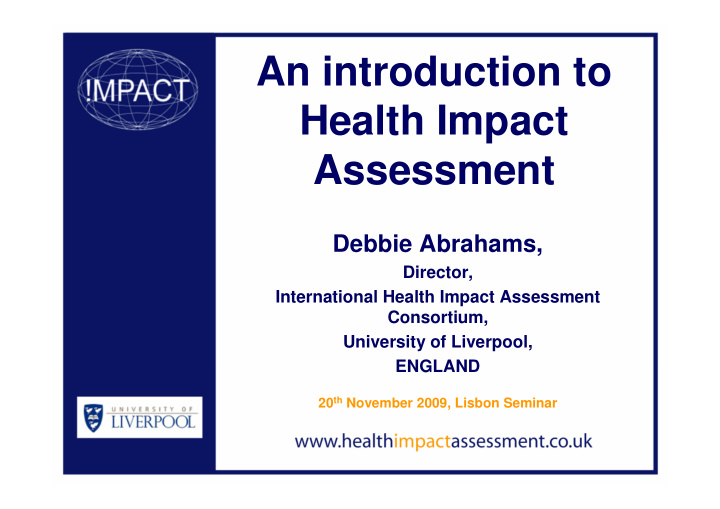



An introduction to Health Impact Assessment Debbie Abrahams, Director, International Health Impact Assessment Consortium, University of Liverpool, ENGLAND 20 th November 2009, Lisbon Seminar
Presentation Overview • What is HIA? • Concepts and definitions • Current policy context
What is HIA? ‘A combination of procedures, methods and tools by which a policy, programme or project may be judged as to its potential effects on the health of a population, and the distribution of those effects within the population.’ ECHP, WHO (1999) Gothenburg consensus paper
What is HIA trying to achieve? • Supports evidence based decision-making , contributing to improvements in health and reduction in health inequalities • Enhance the positive impacts of any decision • Reduce (or eliminate) the negative impacts of any decision
The key HIA output A set of evidence A set of evidence based based recommendations recommendations Specifically designed to Specifically designed to influence decision- -makers makers influence decision
HIA methodologies • Different models of health • Different HIA methodologies, reflecting model of health: � ‘Broad’ perspective � ‘Tight’ perspective
Broad v. tight methodologies Broad Tight perspective perspective View of health Holistic Definition and observation Disciplinary Sociology, Epidemiology, roots epidemiology toxicology Ethos Democratic Technocratic Quantification In general Towards exact terms measurement Key informant Types of Measurements data evidence Precision Low High National Assembly for Wales (1999) Developing health impact assessment in Wales.
HIA Classification Typology Examples Criterion Topic Transport, Employment Type/unit Policy, programme, project, national, local Methodological ‘Broad’ v. ‘Tight’ spectrum perspective Timing Prospective, concurrent Depth Rapid, comprehensive Methods/tool Policy analysis, Profiling Public involvement Stakeholder, ‘consultee’
HIA Classification Quality criterion Examples Reliability/validity Design, methods, tools Transparency/ Openness, impartiality Objectivity ‘Health in All Purpose Policies’ Evaluation Impact, process
HIA Classification Quality criterion Examples Reliability/validity Design, methods, tools Transparency/ Openness, impartiality Objectivity ‘Health in All Purpose Policies’ Evaluation Impact, process
Ron Labonte (1991) Inequalities in Health in the City of Toronto. ihia.org.uk
A socio-environmental model of health determinants (Dahlgren and Whitehead, 1991) ihia.org.uk
Levels of causation and corresponding types of health intervention McKinlay and Marceau (2000), Lancet, 356, 757-761
Principles and values • Socio- • Robust environmental • Public model involvement • Reduce • Shared inequalities ownership • Democratic • Sustainable • Transparent • Practicable • Ethical • Objective
HIA Options Desk- Rapid In-depth based Broad More detailed Comprehensive overview assessment ---- ---- ---- Existing Existing data Multiple accessible and some new methods and data qualitative sources ---- ---- ---- 6 months 2-6 weeks 12 weeks
Guidance on the type of HIA Is the policy a key In-depth policy? Are there significant policy changes proposed?
HIA timing • Reflects policy decision-making time-line/cycle –Prospective HIA (before) –Concurrent HIA (during) –Retrospective HIA (after)
Policy context for HIA in Europe • EC Treaty of Amsterdam, article 152, 1999 • EC Strategic Environmental Assessment, 2001 • EC Public Health Strategy, 2002 • ‘Policy HIA for the EU’ project, 2002-2004: European Policy HIA (EPHIA) methodology • EC Calls using EPHIA • EC Health Strategy, 2008: ‘Health In All Policies’
Policy context for HIA in England • ‘ Independent Inquiry into Inequalities in Health’, 1998 • ‘ Saving Lives’, 1999 • ‘Choosing Health’, 2004 • ‘Our Health Our Care Our Say’, 2006 • ‘Health Inequalities: progress and next steps’, 2008 • ‘Global health 2008-2013’, 2008
Recommend
More recommend